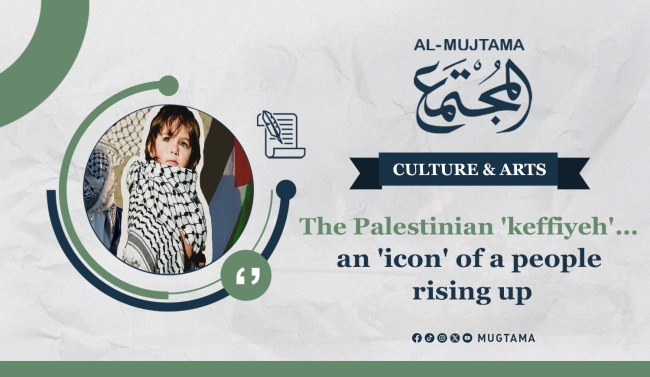The Palestinian 'keffiyeh'... an 'icon' of a people rising up Featured
In their white and black color, intertwined with what resembles a fence made of wire, Palestinians adorn themselves at the points of contact with "Israel" with the Palestinian "keffiyeh," or "Hatta" as they like to call it.
In the form of "a scarf," boys and girls, as well as children, cover their faces with the keffiyeh as they throw stones and Molotov cocktails at the "Israeli" forces, in support of the uprising in the West Bank and Jerusalem. Some of them wrap it around their shoulders and heads or wave it around.
Since the first of October, clashes have been taking place in the Gaza Strip along the borders, and in the West Bank including East Jerusalem, between Palestinian youth and "Israeli" forces. These confrontations erupted due to the insistence of hardline Jews to continue storming the Al-Aqsa Mosque compound, under tight "Israeli" security protection.
The "keffiyeh," which dominates the daily scene in demonstrations and confrontations, is considered a symbol of Palestinian struggle since 1935, according to Palestinian historical studies.
According to the Palestinian National Information Center (governmental), groups of Palestinian revolutionaries, when the British authorities (as Palestine was under British mandate) tightened their control, concealed their identities by wearing the "keffiyeh."
After the outbreak of the Palestinian revolution in 1936, which was a significant turning point during the national movement, the rebels began to wear the keffiyeh, which is said to have originally been a piece of white cloth.
The center mentions that the revolutionaries wore the keffiyeh as a mask to avoid being arrested or reported on, and when the British forces began to arrest anyone who was wearing it, the revolutionaries ordered the sons of the Palestinian villages and cities to wear it.
The "keffiyeh" became a symbol of struggle against the English forces and accompanied the Palestinians in all phases of their struggle.
The Palestinians used the keffiyeh in its white and black colors in the 1960s, and it became a symbol of their contemporary revolution (in 1965), which witnessed the launch of the Palestinian National Liberation Movement (Fatah).
The late Palestinian President, Yasser Arafat, was famous for wearing the keffiyeh, and he never appeared at any national or political event without it. His people’s sons and leaders of factions also wear it on all national occasions.
In the first intifada (1987-1993), wearing the keffiyeh alongside raising the Palestinian flag represented a significant danger for those who did so, as it was, for the Israeli army, a symbol of what it described as "terrorism."
The enthusiasm of young men and boys to wear the keffiyeh became noticeable during the Al-Aqsa Intifada, which erupted on September 28, 2000, following the incursion of the late Israeli Prime Minister Ariel Sharon into the courtyards of Al-Aqsa Mosque.
The keffiyeh began to appear and spread after the signing of the Oslo Accords between "Israel" and the Palestine Liberation Organization in 1993.
Recently, it has been noticeable that Palestinian and Arab media figures are wearing the keffiyeh while presenting news bulletins and analytical programs regarding what is happening in the Palestinian territories.
The keffiyeh is associated with the people of the world as a symbol of solidarity with Palestine. Supporters in various countries wear it during solidarity marches that reject Israeli violations.
Currently, the markets selling the keffiyeh are witnessing notable sales activity, as many people are eager to wear it.
The Palestinians introduced other colors to the production of the keffiyeh, which is characterized by its white color and black stripes, including green, red, and orange, as well as keffiyehs in the colors of their national flag, to keep up with modern times.
Special exhibitions are held in Palestine and abroad to showcase the Palestinian keffiyeh in various forms, alongside other heritage pieces, to display them to visitors and foreign tourists who are interested in purchasing them.
The sons of this people take pride in this symbol, and they say: There is no need for anyone traveling abroad to introduce their identity, as it is enough to wear the keffiyeh for them to be called "Palestinian."


